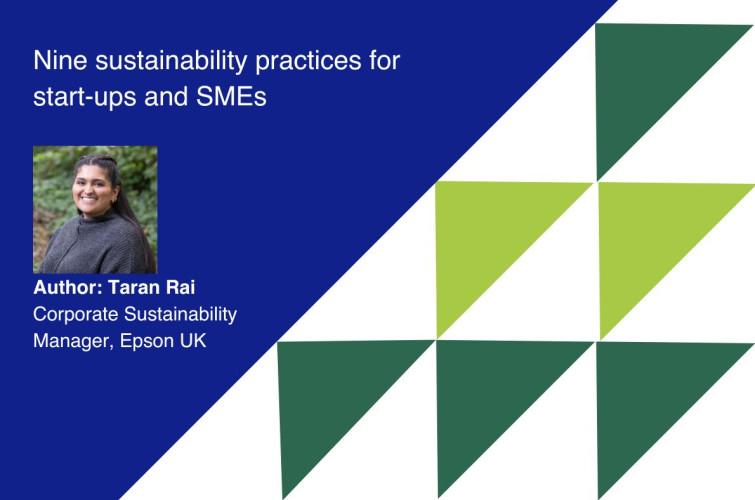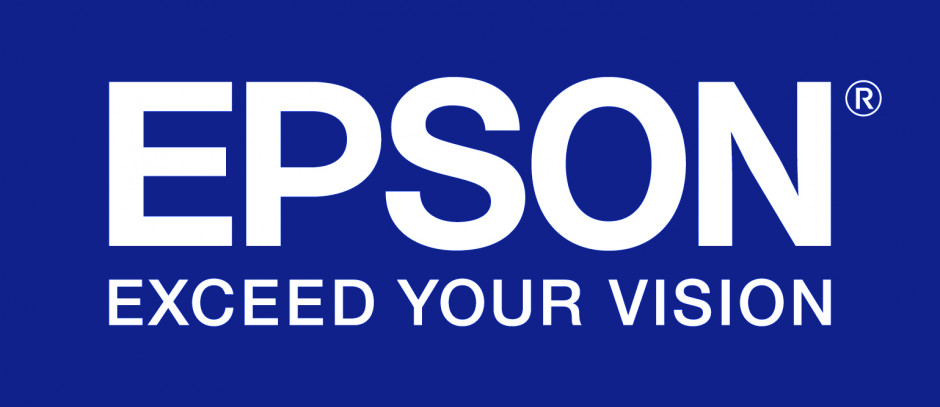Nine sustainability practices for start-ups and SMEs

There’s a lot of noise when it comes to striving for sustainability, and it’s important to me and to Epson that we shine a light for eager businesses to navigate their way through it all. While I’ve written this guide primarily for start-ups and SMEs, a category many of our UK partners fall into, it has equal relevance for large corporates, and I hope it can offer a useful reference point for business of all shapes and sizes. At the same time, while the narrative is aimed at entrepreneurs and business leaders, I equally want this to be something that can be read and understood by any employee, in any role, across any company.
‘Survive then thrive’ tends to be the most popular approach for young start-ups and SMEs, and typically focusses entirely on driving profit, while sustainability can often be viewed as daunting, supplementary, and even unnecessary. But if you plan on sustaining your business, there’s no better way to futureproof yourself against sustainability regulations, public scrutiny, competitor businesses, and customer churn than by proactively integrating sustainability practices into your business. I won’t elaborate on the moral ethics of it – and I hope if you’ve read this far, I won’t have to.
Here is a series of nine, sequential but also standalone practices that I would encourage any start-up or SME to consider while embarking on their sustainability journey:
1. Rate your own sustainability
There's no sense embarking on sustainability initiatives without first understanding the sustainable status of your business. If you want to address the climate crisis, use free online templates like this one from SSE Energy Solutions to roughly calculate your scope 1, 2 and 3 greenhouse gas (GHG) emissions (definitions below), and then try and create a greenhouse gas inventory to pinpoint which environmental impacts you can tackle first. Extend this further with a sustainability audit, materiality assessment and an employee survey to ensure you’re fully understanding your social impact on stakeholders (e.g., employee wellbeing, community engagement) and governance (e.g., ensuring integrity and ethics within the running of the business). Build the foundations for measuring your triple bottom line – people planet and profit – where monthly reports would be inclusive of environmental and social impact metrics in addition to financial. Look at the triple layered business model canvas to see what information and metrics you can report on, what you need to be able to report on the rest, and what you consider immaterial to your business and its stakeholders.
2. Set your own targets
A company without goals is like a ship lost at sea. Now that you’ve set a benchmark with your current sustainability status, you can set ambitious yet realistic targets that cover environmental, social, and governance (ESG). Before you do this, you need to outline a sustainability-oriented vision or strategy that complements your business mission or purpose. This will give you the rationale for certain sustainability practices you may wish to prioritise, and it will provide a useful foundation for your value proposition and increase stakeholder understanding of your brand. As an example, Epson’s purpose is a ‘philosophy of efficient, compact, precise innovation that enriches lives and helps create a better world’, while its environmental vision is to become ‘carbon negative and underground resource free by 2050’. Both purpose and environmental vision complement one another and fit well with Epson’s practice as a technology manufacturer. Once you have your vision, identify accreditation and certification initiatives that resonate with your business strategy and ethos as well as meet the expectations of clients, partners, and employees. For example, consider the frameworks of BCorp, ISO 14001 and World Fair Trade Organization, which each provide essential criteria that business operations should be working towards. This could also help improve your understanding of how to meet the standards and requirements of the UN’s SDGs, the Task Force on Climate-related Financial Disclosures (TCFD) and Sustainability Disclosure Standards (SDS), as the business grows.
|
Scope 1 refers to greenhouse gas (GHG) emissions from sources in direct control by your company such as company cars and onsite energy usage, while scope 2 refers to indirect emissions from energy sources you purchase, such as building electricity and heating. Scope 3 can generate over 90% of emissions and refers to indirect emissions that you are not in direct control of, but they still occur in the value chain. Examples include emissions from products sold, transportation of goods, disposal of products, business travel, and employee commuting. |
3. Evangelise your workforce
Sustainability is everyone’s responsibility, so it’s crucial that you find ways to empower employees to do what they can to drive your sustainability program. Motivate and equip your workforce through learning initiatives such as through the Carbon Literacy Project or conduct workshops with sustainability leaders to inspire your team and create more sustainability-oriented brand advocates of them. Collaborating with local schools, charities, and NGOs is one way to enhance your social impact while offering another gratifying experience for your employees, not to mention increasing your local brand exposure. Create a mandatory sustainability day to create shared understandings of sustainability across the business and understand the different sustainability metrics you can delegate across different departments, roles, and skill types. Employee wellbeing plays an important role in this section, and you should explore different work-life balance and flexible working practices to ensure a more content workforce. Epson UK runs an internal innovation platform that brings employees together from different departments – on a voluntary basis – to work in sustainability-oriented project groups. This not only helps empower individuals with shared interests in sustainability to make a difference, but offers new learning opportunities by engaging people with unfamiliar tasks and stakeholders. Appointing ‘sustainability stewards’ in your business is another great way to increase accountability for sustainability practices but also a great way to keep morale high amongst employees. Epson keeps bees at its ink manufacturing site in Telford and their honey is sold to employees, with revenue invested into the beekeeping, all the while helping foster biodiversity and employee morale.
4. Challenge your suppliers
Every business’s scope 1 greenhouse gas (GHG) emissions are another’s scope 3 emissions, and the further
down the supply chain you go (i.e., the suppliers of your suppliers), the harder it becomes to manage your indirect environmental impact. Quocirca recently reported that only 31% of businesses are extremely satisfied with the sustainability information provided by suppliers, suggesting there’s much scope for you to politely demand of your suppliers: ‘what is your sustainability agenda?’. This could be in the form of adherence to ISO14001, alignment with the UK Green Taxonomy or participation in the gender pay gap report. It could be big or small, environmental or social, industry standard or custom made. Sustainable motivation is contagious and it’s important to know that your key stakeholders are challenging themselves in the same way you are, or at least the way you expect them to. The same research from Quocirca also found that a business’s sustainability goals influence the choice of supplier for 95% of businesses, while 46% said it impacted their choice to ‘a great extent’. Creating this transparency around one another’s sustainability efforts can be a really positive and cohesive step forwards in your professional relationship.
|
Net zero refers to the reduction of GHG emissions from the source, in alignment with the Science-based Targets Initiative (SBTi), and balancing residual emissions through carbon offsetting / carbon removal credits. Carbon neutral refers to using offsetting programmes where carbon credits equivalent to an organisation’s CO2 emissions are purchased without having to reduce emissions from the source. |
5. Keep your own emissions in check
In section 1 we looked at rating your own sustainability. If environmental action is well within your control, there’s no excuse for doing nothing about it. By following the waste hierarchy, which encourages basic circular economy practices – reduce, re-use, and recycle – you can take a step in the right direction. Address your scope 1 GHG emissions by switching to a renewable energy supplier and explore Power Purchase Agreements to save you long-term energy costs. Attend only the offsite meetings you need to and encourage train and bus travel across the company wherever possible. Make use of the UK Workplace charging scheme and encourage staff to switch to electric vehicles, and introduce a carpool incentive scheme for employees to reduce their commuter emissions. Use motion sensor lights and taps to avoid unnecessary energy and water consumption. Explore finance and support offered by public-funded initiatives to drive sustainable practices and see how any of these can be used to reduce your own emissions. Prioritise energy consumption, serviceability, and recyclability when introducing new appliances into the workplace. Heat-free inkjet printing technology for example offers businesses a low-energy printing alternative to laser printing, and Epson provides calculated savings in energy, waste, time, and cost when switching from laser to heat-free inkjet.
6. Assess your products and services
If you’re unfamiliar with the environmental or social impact of the product or service you’re selling, you’re at risk of becoming part of the problem. First conduct or obtain a lifecycle assessment (LCA) of your product or service. This will enable you to be transparent with your customers and it will also help you assess where you can challenge suppliers on their sustainability practices (see section 4). Learn what type of product packaging is used, how products have been shipped, what recyclable material it’s made of, and what recyclability it has. It’s also important to consider the ethical implications of your product or service and how these impact everyone in the supply chain. Are you helping to make the world a better place, or are you exploiting markets with cheap solutions that wreak havoc on the environment or conflict with labour and human rights ethics? What do you want your legacy to look like to future generations? Are you on track to leaving it the way you’d like? If by the end of this you’re not happy with the product or service you’re offering, or you think you can make changes to your offering or supply chain that will significantly benefit its social and/or environmental impact, then don’t wait around for an invitation!
|
Since leaving the EU, the UK is no longer susceptible to European laws around sustainability. However, even though the UK is beginning to forge its own legislative path, don’t entirely disregard EU law as it can act as a ‘crystal ball’ for future UK legislation. Take for instance The European Sustainability Reporting Standards, which provides a guide of indicators European companies should be including in their sustainability reports. The UK has also released the UK Sustainability Disclosure Standards which focuses on UK companies reporting similar aspects. |
7. Create sustainable partnerships
Do not pursue sustainability in isolation when you can achieve bigger and better results by partnering with another organisation. McKinsey outlines that good partnerships should embody clear reasons for collaboration, dedicate good people to the cause, set credible goals, and be flexible in defining success. If no immediate partnerships come to mind or you lack inspiration for finding one, try engaging more with local businesses through the Business Chamber of Commerce and capitalise on their sustainability events and networking opportunities. Put the word out on LinkedIn that you’re exploring partnership opportunities to help achieve a specific goal. Establish a charity partner that complements your brand, resonates with your employees, and offers mutual benefits for both parties. Try shortlisting some organisations to partner with based on carefully selected criteria and put selection to the vote so your workforce feel involved in the decision. Get in touch with your local borough or council to understand which charities, NGOs, or other likeminded companies could be in the market for a mutually beneficial partnership, and go from there. The United Nations Sustainable Development goal #17 (UN SDG 17) features a series of targets for supporting developing countries through innovation, investment, knowledge sharing, and more, but also recommends a range of organisations you can partner with to help you on your sustainability journey.
8. Market your sustainability
Don’t greenwash, but certainly don’t ‘green hush’ either. Sustainable development needs to be recognised and celebrated in moderation to help customers and suppliers make choices based on sustainable merit. Familiarise yourself with the Green Claims directive to better understand what constitutes green washing and what doesn’t so you can find an acceptable balance for delivering your message. Epson utilises tools like the ColorWorks Calculator and the Optimisation Tool to calculate sustainability metrics (e.g., CO2 emissions, waste, and cost) when customers switch from third-party solutions to Epson’s own technologies, all independently verified by industry specialists DataMaster Lab and Smithers, respectively. These data-driven marketing tools help eliminate ambiguity on sustainability and aid customers in making calculated choices around their sustainability criteria that is easier for them and their own stakeholders to understand than marketing jargon. The addition of impartial, third-party certification is also key here to provide you and your stakeholders with assurance. Green Matters lists B Corp, FutureFitBusiness, Planet Mark and One Planet Living among their top certifying bodies for UK businesses, but industry recognitions and awards that include sustainable criteria are also positive marketing messages, providing they are also using third-party moderators or judges. Another important part of marketing your sustainability is to be transparent about your progress. Larger corporations often get stuck trying to ‘put on their best face’ in a bid to match expectations, but don’t be afraid of sharing what’s gone well and what hasn’t worked out. Be forthcoming in the information you share with your stakeholders and you’ll find that it’s better to be seen with integrity than doubt.
9. Continue measuring your progress
What gets measured gets done, and if you’ve taken the steps to rate your business’s sustainability (section 1), then you’re already on track for reporting progress at a consistent pace based on targets and frameworks from section 2. Measuring your sustainability progress helps you validate your efforts, maintain momentum amongst employees responsible for sustainable practices, and demonstrate your sustainable value to your stakeholders. This creates appeal not only for investors, customers, and employees, but also prospective employees, as nearly 50% of young adults want their employer to demonstrate a commitment to ESG (environmental, social, governance). As a start-up or SME, you won’t want to embellish reporting with fanciful literature, but equally, don’t worry about reporting the full breadth of environmental, social, governance, and profit-based metrics either. Instead, take a tiered approach by reporting on what’s available and what’s important to your business, and if/when you start addressing wider issues and achieve new metrics, you can start welding them into your reporting. Useful reporting tips from PWC that I’d particularly recommend for start-ups and SMEs include: avoid glossing over negative sustainability or poor performance, show how your sustainability strategy has impacted your profit, and explain how the sustainability governance system operates. Getting on top of your sustainability reporting now will give you a head start as smaller organisations will be required to follow sustainable reporting legislations in the future.















